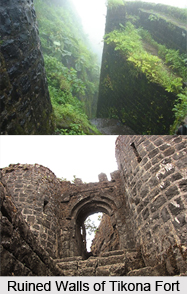 Tikona Fort, also known as Vitandgad Fort, is located in Maval tehsil in the district of Pune in Maharashtra state. It is situated close to Kamshet and is almost 60 km away from Pune. The geographical coordinates is latitude 18.6317°N 73.5128°E. The fortress was constructed mainly with stone and mortar. It was built on the top of a hill with an altitude of 3500 feet. The nearby village is known as Tikona Peth (Tokono Peth). It has become a popular tourist destination due to the Satavahana caves, the Trimbakeshwar Mahadev temple, a water reservoir and the massive gateways. At the peak of hill there is a lake which attracts several visitors as well.
Tikona Fort, also known as Vitandgad Fort, is located in Maval tehsil in the district of Pune in Maharashtra state. It is situated close to Kamshet and is almost 60 km away from Pune. The geographical coordinates is latitude 18.6317°N 73.5128°E. The fortress was constructed mainly with stone and mortar. It was built on the top of a hill with an altitude of 3500 feet. The nearby village is known as Tikona Peth (Tokono Peth). It has become a popular tourist destination due to the Satavahana caves, the Trimbakeshwar Mahadev temple, a water reservoir and the massive gateways. At the peak of hill there is a lake which attracts several visitors as well.
History of Tikona Fort
Tikona Fort was probably built between the 7th Century A.D. and the 8th Century A.D. the fortress was occupied by Malik Ahmed Nizamshah who belonged to the Nizam in 1585. It was then annexed to the territory of the Nizams. The Great Maratha Emperor Shivaji took control over the entire Konkan region which was also the Nizam territory in 1657. Chatrapati Shivaji Maharaj captured Tikona Fort along with various other forts namely, Visapur Fort, Tala Fort, Songad Fort, Mahuli Fort, Lohgad Fort and Karnala Fort.
The fortress of Tikona served as the control centre for the entire Pawana Mawal area. The Dhamale clan was entrusted with the maintenance and security of Tikona Fort in 1660. The Dhamale family was one of the Deshmukh from Maval region. In the year 1665, the territory and the neighbouring villages was attacked by Jaysingh and Diler Khan. However, they were unable to invade the fortress. Later the fort was invaded by Halal Khan, Kubad Khan and others from the army of the Mughal Dynasty. It was surrendered to the Mughals under the Treaty of Purandar on 12 June 1665. Kubad Khan took control of Tikona Fort on 18 June 1665. However it was eventually re-occupied by the forces of the Maratha Empire.
Present Condition of Tikona Fort
Tikona Fort is presently in a ruined state. The site has been developed as a tourist destination and is maintained by the Government of India. Tikona Fort is visited by many tourists and trekkers throughout the year.



















